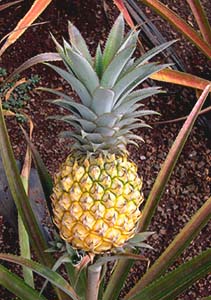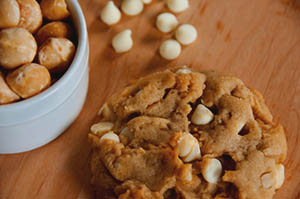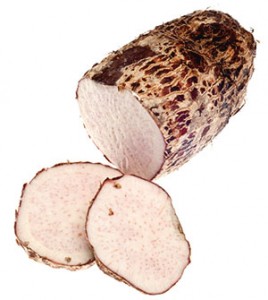 I feel blessed every day to live on Hawaii: the island’s semi-tropical climate ensures there isn’t so much as a growing season as an all-year growing extravaganza for so many diverse Hawaiian crops! Many of these crops have been delicious and nutritious staples of our indigenous cuisine for centuries; I certainly can’t imagine cooking somewhere I couldn’t get fresh papaya, taro, and pineapple at all times! Now that refrigeration and air shipping have made Hawaiian produce available on the mainland, some crops like Kona coffee, pineapples, and macadamia nuts have come to represent the essence of Hawaii to many people!
I feel blessed every day to live on Hawaii: the island’s semi-tropical climate ensures there isn’t so much as a growing season as an all-year growing extravaganza for so many diverse Hawaiian crops! Many of these crops have been delicious and nutritious staples of our indigenous cuisine for centuries; I certainly can’t imagine cooking somewhere I couldn’t get fresh papaya, taro, and pineapple at all times! Now that refrigeration and air shipping have made Hawaiian produce available on the mainland, some crops like Kona coffee, pineapples, and macadamia nuts have come to represent the essence of Hawaii to many people!
Long before Europeans came to the islands, Hawaii was a farmer’s paradise: a mild climate, regular rainfall, and rich volcanic soil combined to make it a very fertile region. Crops being grown at the time of European contact included breadfruit, sweet potato, sugarcane, coconut, taro, and of course, kava kava. Colonization and agricultural trade brought with them some of the most famous Hawaiian crops, including macadamia nuts (from Australia) and the pineapple (from central South America). That’s right—these two most famous Hawaiian crops are not actually from Hawaii at all! However, Hawaii was where they got their start as cash crops.
For instance, even though macadamia trees had been grown ornamentally on Hawaii since 1882, their nuts didn’t become a commercial crop until the 1950s. You see, it turns out macadamias really are a tough nut to crack: breaching the shell requires the application of 300 pounds of pressure per square inch!! But with the invention of mechnical shelling, macadamia nuts became profitable; Hawaii now produces 90% of the world’s macadamias, and these days you can get them roasted and salted, as macadamia nut oil, or—my personal favorite—embedded in rich dark chocolate!
Macadamia nuts are a main ingredient of these scrumptious white chocolate chip cookies.
The pineapple is a different story. While pineapples may have come to Hawaii as early as 1527 on board a wrecked Spanish galleon, it was Don Francisco de Paula y Martin, King Kamehameha’s Spanish advisor, who officially brought the first pineapples to the islands in 1813. Produce giants Dole and Del Monte both established pineapple plantations in Hawaii, and for a while 80% of the world’s pineapples were grown here—but recent years have seen a decline as companies moved to less expensive tropical regions for their pineapples.
Yet there are still some crops that I believe will always be distinctly Hawaiian. Take taro, a starchy tuber that has remained a staple of Hawaiian and South Pacific cuisine for thousands of years. When raw, taro tubers are creamy white with purple strands; cooked or made into flour, they turn a lovely purple. I can’t think of any dish more Hawaiian than po’i (taro paste): sort of the Hawaiian version of hummus, po’i makes an excellence palate cleanser after the spicy or rich foods that make up pupu platters, commonly taken between kava drinking sessions. Taro is a motif in our culture as well: the native word for family, ohana, is taken from oha, the shoot that grows from the taro tuber. As the young shoot grows from the tuber, so people also grow from their family while remaining connected. I’ve always loved this wonderful image!
Taro can be curried, baked, made into flour, or sliced and roasted for delicious taro chips!
Then there’s the coveted Kona coffee, often touted as one of the most delicious varieties in the world. Kona coffee grows only in the fertile microclimate of the Hualalai mountains near Kona, Hawaii. Peaberry, the best grade of Kona coffee, can command prices as high as $50/lb! For true coffee connoisseurs, the price is worth Kona coffee’s unforgettably rich, layered and complex flavor, not to mention the pride of supporting the generational family farms that still produce the majority of Kona coffee on the market.
Speaking of small family farms… have I mentioned kava kava? It may not (yet) have the same cachet as pineapples or macadamia nuts, but I see signs every day that kava is moving into the public consciousness as a gentle and compassionate plant healer. There are forms of kava grown in Hawaii that were once found nowhere else, such as the Nene, Mo’i, sacred black Hiwa, and of course, our sweet, almost tea-like Mahakea strain. Perhaps in the future, kava kava will even surpass the pineapple as the quintessential Hawaiian crop. Hey, a farmer’s daughter can dream, can’t she?







